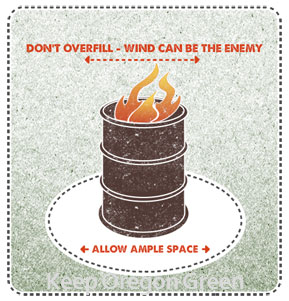
|
Chip, Compost, or Recycle Yard Debris. Don't Burn it. If debris burning is your only option, follow these tips. Click a link below to view a PDF on the Do's and Dont's of Debris Burning (OSFM website)
Open Burning is allowed seasonally and is adjusted if the Summer Fire Season starts early or ends late.
A large portion of Stayton Fire District (roughly East of Stayton city limits and North of the Santiam River) is within the Oregon Department of Forestry (ODF) North Cascade Protection District Boundaries. No burning is allowed if you live in the ODF protection areas and during their ODF-declared fire season, which typically starts in June and can run until significant rains in the fall.
To see if you live within ODF protection boundaries, click here to view a map where you can click on your approximate location to view daily fire danger and current fire restrictions.
Daily Burn Information Line
1-877-982-0011 or click here and click on the "Daily Burning Information" link on the right side of the page. (Updated each day after 9 am)
Open Burning Seasons is regulated by the Oregon Department of Environmental Quality (DEQ)
Check it Out! DEQ has launched a map-based tool to help people better understand outdoor burning restrictions in Oregon! The new tool and information about burning across the state can be found on DEQ’s Open and Outdoor Burning web page. Look for the "Can I Burn Mapping Tool" at https://www.oregon.gov/deq/aq/Pages/Burning.aspx.
SPRING – Projected for March 1 through June 15 (projected and is dependent on fire conditions)
FALL – Projected for October through December 15 (projected and is dependent on fire conditions)
Burn Responsibly - Before You burn, click here for Safety Tips!
Open Burning Questions or Complaints
- Burning Regulations: Oregon Department of Environmental Quality (DEQ)
- File a Complaint by phone or online.
Backyard Burning(Open Burning)
It is burning debris in an outdoor fireplace, burn barrel, backyard incinerator, or piles of yard debris. You can only burn during Open Burning Seasons - call the daily burn information line before you burn.
Allowed Materials - What can I burn?
You can burn yard debris: wood, needles, or leaves from plants grown and burned on the property of origin.
Prohibited Materials - What can I not burn?
It is illegal to burn the following materials any time, anywhere in Oregon: asbestos, asphalt or industrial waste, automotive parts (including frames), dead animals, plastic and rubber products, tires, waste oil, petroleum treated and related materials, and wet garbage and food waste, or any material creating dense smoke or noxious odors. Visit the DEQ website and select your County to check for additional restrictions.
Agricultural Burning
Agricultural burning: Burning of any agricultural waste generated by an agricultural operation that uses or intends to use land primarily for the purpose of obtaining profit by raising, harvesting, and selling crops or animals. Prohibited materials such as tires cannot be burned, even in an agricultural setting. If you make your primary living from an agricultural operation, you are considered an agricultural operator and can agricultural burn. If you don't make your primary living from the agricultural operation, you are a backyard burner and subject to backyard burning rules. Contact your local fire district for information about backyard burning. Learn More
Ag Burning during Fire Season
All agricultural burning (except Field Burning, which is regulated separately) from June 16 through October 15 requires a burn permit issued by Stayton Fire District (503-769-2601).
Field Burning
The Oregon Department of Agriculture regulates the burning of residue from grass seed crop harvests. If you have a complaint about field burning, please call the Department of Agriculture (ODA) at 503-986-4709. If you have questions, call 503-986-4701 or email ODA. https://www.oregon.gov/oda/agriculture-services/smoke-burning/Pages/default.aspx
Slash Burning
The burning of limbs and debris leftover from a timber harvest (logging) operation. If you live within ODF-protected lands, you must get a slash-burn permit from ODF (503-859-2151).
If you choose to burn your yard debris, when allowed, burn responsibly and follow these safety tips:
Know the weather forecast. Never burn on very dry or windy days, as the fire can easily spread out of control.
Burn only yard debris. State regulations prohibit the open burning of any material that creates dense smoke or noxious odors.
Keep your burn pile small, or use a burn barrel. Clear at least a 15-foot radius around a barrel and at least a 25-foot radius around your burn pile, and make sure there are no tree branches or power lines above. Wet down the surrounding area before, during, and after the burn.
Always have water and fire tools on site. Keep a water-charged hose, a bucket of water, a shovel, and dirt or sand nearby to extinguish the fire. Stay with the fire. Oregon law requires you to continually monitor a debris burn from start to finish until it is completely out.
Extinguish the fire. Drown the burn pile with water, stir the coals, and drown again. Repeat until the fire is completely out.
Recheck the fire. Go back and recheck old burn piles, as they can retain heat for several weeks and rekindle when the weather warms and the wind begins to blow.
